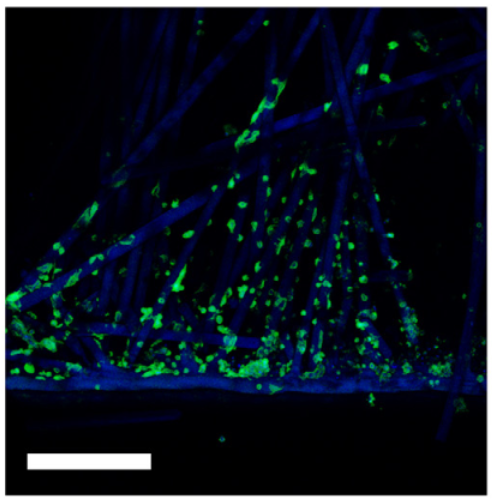Electrostatic flocking of chitosan fibres leads to highly porous, elastic and fully biodegradable anisotropic scaffolds.
Electrostatic flocking - a common textile technology which has been applied in industry for decades - is based on the deposition of short polymer fibres in a parallel aligned fashion on flat or curved substrates, covered with a layer of a suitable adhesive. Due to their highly anisotropic properties the resulting velvet-like structures can be utilised as scaffolds for tissue engineering applications in which the space between the fibres can be defined as pores. In the present study we have developed a fully resorbable compression elastic flock scaffold from a single material system based on chitosan. The fibres and the resulting scaffolds were analysed concerning their structural and mechanical properties and the biocompatibility was tested in vitro. The tensile strength and Young's modulus of the chitosan fibres were analysed as a function of the applied sterilisation technique (ethanol, supercritical carbon dioxide, gamma-irradiation and autoclaving). All sterilisation methods decreased the Young's modulus (from 14GPa to 6-12GPa). The tensile strength was decreased after all treatments - except after the autoclaving of chitosan fibres submerged in water. Compressive strength of the highly porous flock scaffolds was 18±6kPa with a elastic modulus in the range of 50-100kPa. The flocked scaffolds did not show any cytotoxic effect during indirect or direct culture of human mesenchymal stem cells or the sarcoma osteogenic cell line Saos-2. Furthermore cell adhesion and proliferation of both cell types could be observed. This is the first demonstration of a fully biodegradable scaffold manufactured by electrostatic flocking. STATEMENT OF SIGNIFICANCE: Most tissues possess anisotropic fibrous structures. In contrast, most of the commonly used scaffolds have an isotropic morphology. By utilising the textile technology of electrostatic flocking, highly porous and clearly anisotropic scaffolds can be manufactured. Flocking leads to parallel aligned short fibres, glued on the surface of a substrate. Such structures are characterised by a high and adjustable porosity, accompanied by distinct stiffness in fibre direction. The present article describes for the first time a fully biodegradable flock scaffold, solely made of chitosan. Utilisation of only one material for manufacturing of flock substrate, adhesive and fibres allow a uniform degradation of the whole construct. Such a new type of scaffold can be of great interest for a variety of biomedical applications.

- Acta Biomater. 2016 Oct 15;44:267-76
- 2016
- Medical Biology
- 27544815
- PubMed
Enabled by:
